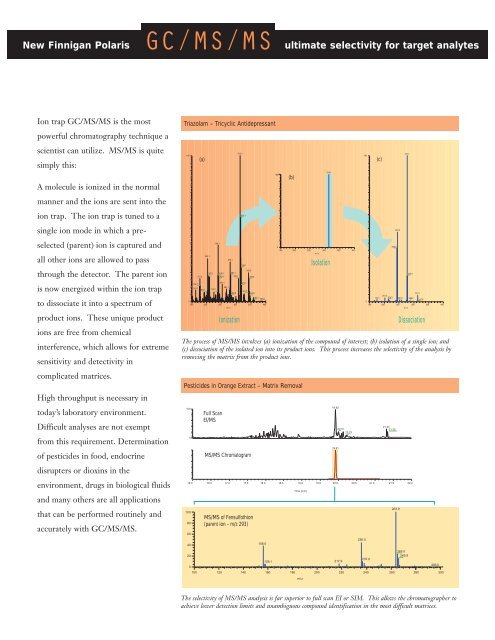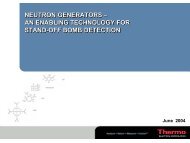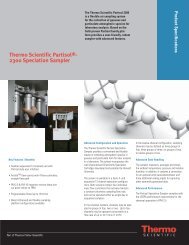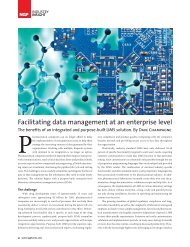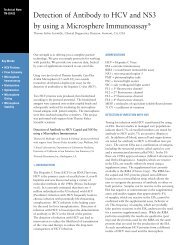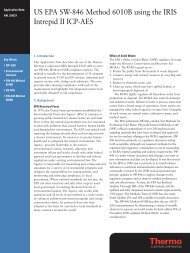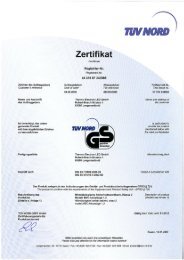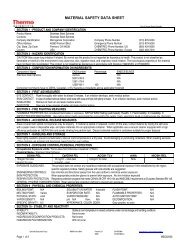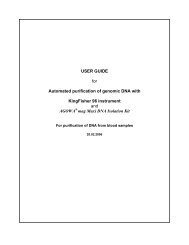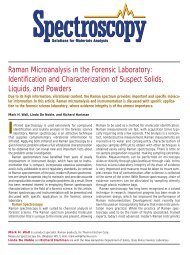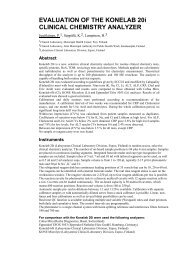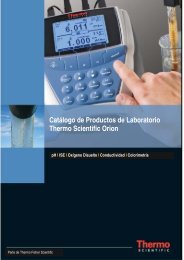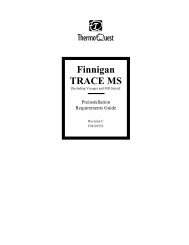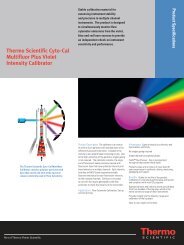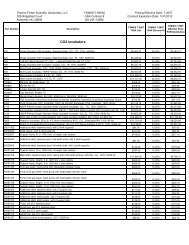POLARIS GC/MS
POLARIS GC/MS
POLARIS GC/MS
You also want an ePaper? Increase the reach of your titles
YUMPU automatically turns print PDFs into web optimized ePapers that Google loves.
New Finnigan Polaris <strong>GC</strong>/<strong>MS</strong>/<strong>MS</strong> ultimate selectivity for target analytes<br />
Ion trap <strong>GC</strong>/<strong>MS</strong>/<strong>MS</strong> is the most<br />
powerful chromatography technique a<br />
scientist can utilize. <strong>MS</strong>/<strong>MS</strong> is quite<br />
simply this:<br />
A molecule is ionized in the normal<br />
manner and the ions are sent into the<br />
ion trap. The ion trap is tuned to a<br />
single ion mode in which a preselected<br />
(parent) ion is captured and<br />
all other ions are allowed to pass<br />
through the detector. The parent ion<br />
is now energized within the ion trap<br />
to dissociate it into a spectrum of<br />
product ions. These unique product<br />
ions are free from chemical<br />
interference, which allows for extreme<br />
sensitivity and detectivity in<br />
complicated matrices.<br />
High throughput is necessary in<br />
today’s laboratory environment.<br />
Difficult analyses are not exempt<br />
from this requirement. Determination<br />
of pesticides in food, endocrine<br />
disrupters or dioxins in the<br />
environment, drugs in biological fluids<br />
and many others are all applications<br />
that can be performed routinely and<br />
accurately with <strong>GC</strong>/<strong>MS</strong>/<strong>MS</strong>.<br />
Triazolam – Tricyclic Antidepressant<br />
100<br />
0<br />
150<br />
100<br />
203.1<br />
238.1<br />
279.1<br />
316.1<br />
342.0<br />
207.1 239.1 281.1<br />
177.2<br />
240.1 307.1<br />
343.9<br />
176.1<br />
253.1<br />
317.1<br />
163.1<br />
202.1 237.1<br />
267.1<br />
282.2<br />
341.1<br />
344.9<br />
361.1<br />
386.0<br />
0<br />
200 250 300 350 400<br />
m/z<br />
313.1 277.1<br />
100<br />
315.1<br />
100<br />
0<br />
150<br />
313.1<br />
200 250 300 350 400<br />
m/z<br />
16.0 16.5 17.0 17.5 18.0 18.5 19.0 19.5 20.0 20.5 21.0 21.5 22.0<br />
100<br />
80<br />
60<br />
40<br />
20<br />
0<br />
(a)<br />
19.92<br />
20.01<br />
20.23<br />
0<br />
150<br />
174.1<br />
242.2<br />
243.2<br />
278.1<br />
201.2<br />
214.2 251.2 286.2<br />
313.1<br />
313.8<br />
200 250 300 350 400<br />
m/z<br />
The process of <strong>MS</strong>/<strong>MS</strong> involves (a) ionization of the compound of interest; (b) isolation of a single ion; and<br />
(c) dissociation of the isolated ion into its product ions. This process increases the selectivity of the analysis by<br />
removing the matrix from the product ions.<br />
Pesticides in Orange Extract – Matrix Removal<br />
Full Scan<br />
EI/<strong>MS</strong><br />
<strong>MS</strong>/<strong>MS</strong> Chromatogram<br />
<strong>MS</strong>/<strong>MS</strong> of Fensulfothion<br />
(parent ion - m/z 293)<br />
156.0<br />
158.1<br />
(b)<br />
Time (min)<br />
21.33<br />
21.35<br />
100 120 140 160 180 200 220 240 260 280<br />
m/ z<br />
Isolation<br />
Ionization Dissociation<br />
The selectivity of <strong>MS</strong>/<strong>MS</strong> analysis is far superior to full scan EI or SIM. This allows the chromatographer to<br />
achieve lower detection limits and unambiguous compound identification in the most difficult matrices.<br />
19.91<br />
217.9<br />
236.0<br />
237.0<br />
(c)<br />
263.9<br />
265.0<br />
265.9<br />
293.0<br />
300


